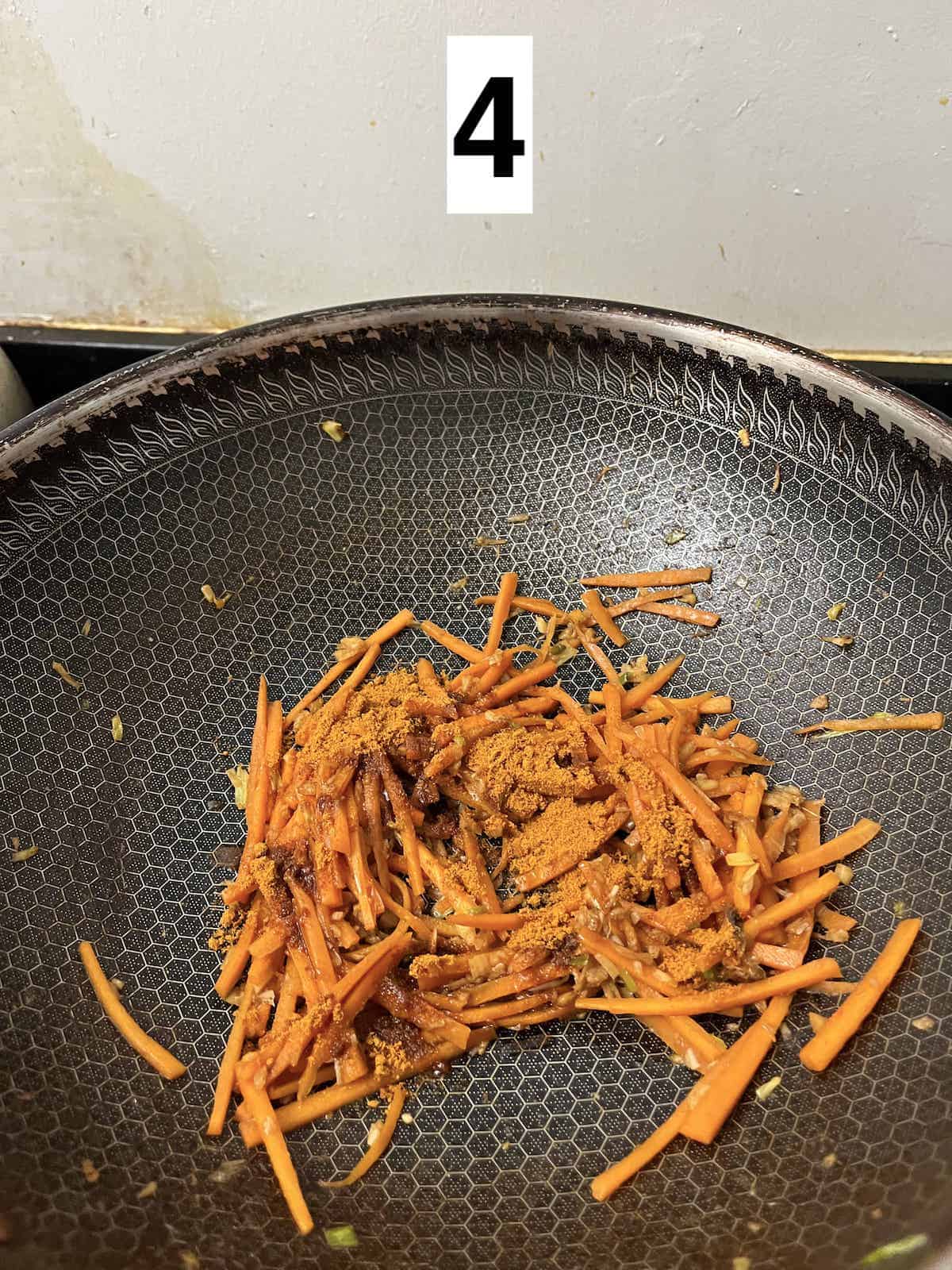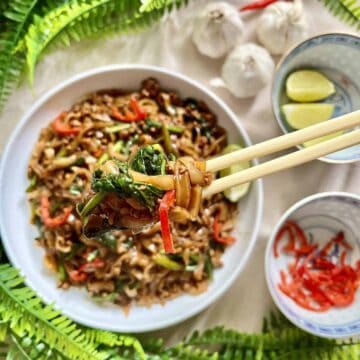Shrimp Mei Fun is an easy Stir Fried Thin Rice Noodles Dish. Packed with shrimp and vegetables, it's a complete meal with fibre and protein that can be made in under 30 minutes!

Jump to:
⭐ Why This Recipe is a Star
- Shrimp Mei Fun is delicious: sweet, a little spicy, and with warm curry flavors, this noodle dish also has juicy shrimp, sweet veggies and al dente noodles.
- It's a meal in itself: you can stir fry the rice noodles with so many other ingredients, from proteins such as shrimp, tofu and char siu to vegetables such as cabbage and carrots. (You can even add leftover bak kwa in place of char siu.)
- And done in under 30 minutes: quick and easy, with less washing up since it's a 1-wok/pan meal!
Note: you do not need a large wok to cook this! A large skillet would do too.
🥘 What is Mei Fun?
"Mei Fun" is the Cantonese word for Rice Noodles, usually found as long, white and thin vermicelli strands. It's also known as Mi Fen (米粉 in Mandarin, literal translation "rice powder"), Mai Fun, Rice Vermicelli, Rice Noodles, Mee Hoon, Bee Hoon or Bihun.
Though thin, the noodles have a spinginess to them. They cook super easily so you can either soak them in hot water for 10 minutes or so, or blanch them quickly in boiling water. You'll see them in many Chinese and South East Asian recipes such as stir-fries and soups.
Mei Fun is a popular dish at American Cantonese restaurants and can be served with a variety of different sauces. The ingredients can be anything from leftover roast chicken to shrimp, so it's a very versatile dish!
Shrimp Mei Fun, in particular, usually refers to "Singapore Noodles" (Singapore Mei Fun) which is rice vermicelli stir-fried with curry powder. Like Lo Mein and Chow Mein, it is a Chinese takeout staple!
Note: As a Singaporean, I feel it is my civic duty to tell you that no such noodle exists in Singapore! This is an invention by Cantonese takeout restaurants in the UK/ US. (I had this dish A LOT when studying at the University of St. Andrews in far-flung Scotland!) For real Singaporean noodles, try bihun goreng or stir-fried mee siam.
🥘 Ingredients
You will need a few simple ingredients for this popular Chinese dish (nothing fancy like Hoisin Sauce so no special trip to the Asian supermarket needed!):
- rice vermicelli: use the dried one which is more common. I mean, even when I live in Asia, I don't see fresh vermicelli everywhere! If not, you can try 1 of these vermicelli substitutes. (I do not recommend glass noodles though as it absorbs all the sauce and there isn't much flavour.) Don't cook these thin rice noodles for too long as you want to keep the al dente texture. I recommend just soaking them in a large bowl of hot water for 10-20 minutes (till soft and pliable.) I cut them here, but if serving this at Chinese New Year, don't- the longer the noodles, the longer one's life! (They also break easily if overcooked so you want to rinse in cold water after blanching.)
- Curry power: it's not Singapore noodles without the curry powder so don't leave this out! Add turmeric powder (optional) to get a more beautiful golden hue and a warmer flavor.
- shrimp: I used defrosted frozen ones but you can also use fresh shrimp. Don't forget to devein them and to marinate with Shaoxing cooking wine to remove the seafood smell! Other protein substitutes or additions are tofu, shredded chicken, lup cheong (Chinese sausage), fish cakes, crab sticks, pork, leftover Char Siu/ thin strips of roast pork (recommended) and beef.
- Aromatics such as Fresh ginger, shallots and spring onions: you can use red onions instead of shallots. If you want to add garlic, feel free to do so!
- Eggs: Chinese stir-frying needs you to be quick, so mis-en-place is very important. Have the beaten eggs in a small bowl next to your wok/ pan ready to go!
- Carrots or other vegetables, julienned: I only used carrots this time but I do throw in whatever leftover greens I have. This is a great fridge clear-out recipe! You can use cabbage, corn, bell peppers, snow peas, bean sprouts, napa cabbage or green beans. (Avoid ones like bok choy, mushrooms, choy sum and spinach as they release a lot of water. If not, you need to saute them before adding them to the noodles.)
- For the sauce, Fish Sauce, Sesame Oil and Soy Sauces: we want both light and dark soy sauce here. If you're on a celiac diet, use tamarind instead of light soy sauce.
- Optional garnish, sliced red chili and green onions

🔪 Step-by-Step Instructions

1a. Let the noodles soak in hot water for 10-20 minutes till soft and pliable. (You can go on to step 2a here and continue Step 1b once the noodles are soft.)
1b. Once soft, drain and rinse with cold water in a colander to stop the "cooking."Mix the noodles with dark soy and sesame oil

2a. Whilst the noodles are soaking, mix the shrimp with the light soy sauce.
2b. Heat oil in the wok on medium heat till very hot and shimmering then pan-fry the shrimp.
2c. Once cooked, plate them. (We cook the prawns separately to ensure they aren't overcooked later.

3. Increase the heat to high. In the same wok (no need to clean it), stir-fry the ginger, shallots and spring onions till fragrant. You may need to add a bit more oil. Keep stirring so they don't burn. (If they're burning and you can't toss them quickly enough, reduce to medium-high heat.)

4a. Add the carrots/ other vegetables, and stir-fry for a minutes till the carrots have softened.
4b. Add the curry powder and sauces then mix well in the wok.

5. Pour in the beaten egg and scramble it.

6a. When the egg is almost fully cooked, add the noodles and stir. Taste to see if extra salt and/ or sugar are needed.
6b. Once the seasoning is done, tip in the prawns, and stir till heated up then serve
🥡 How to Store
Extra can be kept in an airtight container in the fridge for 2-3 days.
I do not recommend freezing these noodles!
👩🏻🍳 Expert Tips
Tip #1: If you specifically want to recreate what you get at Chinese restaurants, then it's usually Napa cabbage, carrots, shrimp, char siu, eggs and spring onions. For authentic takeout flavor, you'll also need a pinch of MSG or a chicken stock powder!
💭 Recipe FAQs
Made from rice and water, these noodles are usually gluten-free and vegan but check the packaging as they may be made in the same facility as non-GF condiments. (Chinese sauces, such as light soy sauce, are often not GF as they contain wheat FYI.)

🥗 Other Recipes
Enjoyed this easy Stir-fried Shrimp Vermicelli Recipe? Please leave a 5-star 🌟🌟🌟🌟🌟rating in the recipe card below! If you REALLY liked this Cantonese takeout copycat recipe, please consider supporting it by buying me a coffee! 🙂 (No obligation though!) Thank you and have a great day!

Shrimp Mei Fun (Fried Rice Noodles)
Ingredients
Marinating the shrimp
- 12-16 shrimp peeled and deveined. Keep the shells for prawn oil or prawn stock!
- 1 Tablespoon Shaoxing wine removes any fishy flavors from the prawns
- 1 Tablespoon light soy sauce
Preparing the noodles
- 5 oz dried rice noodles
- 2 teaspoons sesame oil
- 2 teaspoons dark soy sauce
For stir-frying
- 1 Tablespoon neutral vegetable oil For authentic Chinese flavor, don't use olive oil. You may need to add more if the wok looks dry.
- 2-3 shallots finely sliced Substitute: red onions
- 2-3 sprigs spring onions sliced thinly
- ½ inch Ginger minced. You can add 2-3 cloves of minced garlic too if you want.
- 1 medium carrot julienned
- 2 Tablespoons curry powder Add ½ teaspoon of turmeric powder if you want your noodles to be a more vibrant yellow.
- 1 teaspoon fish sauce
- 1 teaspoon light soy sauce
- ¼-½ teaspoon white sugar or to taste
- ⅛ teaspoon white pepper optional, as this isn't the most common ingredient outside a Chinese kitchen. Do not substitute with black pepper.
- 2 medium eggs beaten
- ½ Salt or to taste
Instructions
- Let the noodles soak in hot water for 10-20 minutes till soft and pliable. (You can go on to step 2 here and finish the rest of this finish once the noodles are soft.)Once soft, drain and rinse with cold water in a colander to stop the "cooking."Mix the noodles with dark soy and sesame oil
- Whilst the noodles are soaking, mix the shrimp with the light soy sauce. Heat oil in the wok on medium heat till very hot and shimmering then pan-fry the shrimp. Once cooked, plate them. Note: We cook the prawns separately to ensure they aren't overcooked later.
- Increase the heat to high. In the same wok (no need to clean it), stir-fry the ginger, spring onions and shallots till fragrant. You may need to add a bit more oil. Keep stirring so they don't burn. (If they're burning and you can't toss them quickly enough, reduce to medium-high heat.)
- Once aromatic, add the carrots/ other vegetables, and stir-fry for a minutes till the carrots have softened.
- Add the curry powder and sauces then mix well in the wok. (If using turmeric powder, this is the time to add it too.)
- Pour in the beaten egg. (The curry powder is why your eggs look extra yellow.)
- Add the noodles and stir. Taste to see if extra salt and/ or sugar are needed. Once the seasoning is done, toss in the prawns, and stir till heated up then serve
Notes
Note: the nutritional information is an estimate automatically calculated using the WPRM recipe maker and I am not responsible for its veracity.
Nutrition
If this Singapore Shrimp Noodles recipe was helpful, maybe you'd like to sign up for my newsletter in which I send you more tips and tricks to make authentic Asian food?









Dorene chew says
One of my favourites!